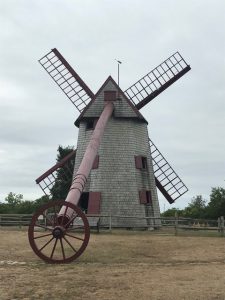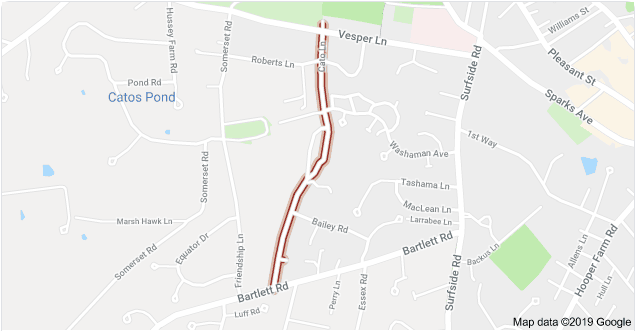 The last surviving windmill on Nantucket (ca. 1746) is also the oldest operational mill in the United States. It is mentioned in one of Cato Cary’s deeds.
The last surviving windmill on Nantucket (ca. 1746) is also the oldest operational mill in the United States. It is mentioned in one of Cato Cary’s deeds.
In my very first post for Vita Brevis, I mentioned that I’d learned a wonderful tip from NEHGS staff: many historic Massachusetts land deeds can be browsed free online through Family Search. Since NEHGS serves lots of folks with family roots in Massachusetts, this is a valuable resource for many of this blog’s readers.
Armed with this knowledge, I sat down at my computer expecting to discover family real estate transactions … which I definitely found in spades. However, various other deeds were also recorded that I had not expected to find, including those for ships and even church pews. Then I found another kind of deed that really knocked me for a loop: a deed of manumission. It had never occurred to me that documents freeing slaves might be recorded alongside those for houses and farms. The man receiving manumission even shared a name with the man I wrote about in my last post: Cato, a former slave of John Hancock.
In the late eighteenth century, my great-great-great-great-great-grandfather signed and sealed the following deed of manumission, which I quote verbatim so that all can see the exquisite thoroughness of the lawyer who drafted it (though I would definitely vote for more punctuation!):
Know All Men by these presents that I Edward Cary[1] of Sherburn in the County of Nantucket Ropemaker for Divers Good lawful and Reasonable Causes & Considerations me thereunto moving have Remised Released Manumitted and Discharged & do by these Presents for my Self and my Heirs Remise Release Manumit & Discharge my Negro Servant Man Named Cato, from any further Servitude for me or my Heirs from hence forth and for ever; hereby openly and Solemnly Declaring that from the Day of the Date of these presents he my said Servant Man Cato is Absolutely and Entirely free & Discharged to all Intents purposes & Constructions whatsoever from all Manner of Detention of his Body or personal Service of Every kind, which I the S[ai]d Edward Cary or my Heirs might have Claim Challenge or Demand of him the S[ai]d Cato by virtue of any former Bill of Sale Contract or W[r]iting Obligatory of any kind or Nature Whatsoever heretofore had made or Done; so that the s[ai]d Cato from and after the Ensealing and Delivery of these presents may go about his lawful Occasions without any Hindrance or Restraint from me or my Heirs; and in his Own Name & Person may Act Manage and transact all Lawful affairs Matters & things whatsoever in Trade or Commerce or otherwise, as legally and Warrantably as any other of his Majesties [sic] free born Natural Subjects In Witness whereof I the said Edward Cary have hereunto set my Hand and Seal this Twenty first Day of June and in the fourteenth Year of his Majesties [sic] Reign Annoque Domini 1774
The very next day, Edward Cary sold Cato a house and ten rods of property on which the house stood, in consideration of forty-two pounds, thirteen shillings, and four pence. This property was located “Southward and Westward of the Wind Mills,” and included one-quarter part of the well adjacent. Both this document and the deed of manumission were witnessed by Thomas Starbuck, Junr., another of my great-great-great-great-great-grandfathers. A decade later, on 20 April 1784, Edward Cary sold Cato, “a free Negro … Labourer,” an additional seventy square rods of land adjacent to his house lot, in consideration of thirty-one pounds and ten shillings. The two parcels of land together constituted one-half acre.
By the time Cato bought the second parcel of land, he had someone with whom to share his property: Hannah Panchame, a woman of Wampanoag Indian ancestry, whom he married on 7 October 1781. In records for this marriage his name was recorded as Cato Cary. What happened to Cato afterwards is unclear, and apparently he and Hannah had no children. However, he did not fade entirely into obscurity. While he may have technically owned only half an acre, the whole area surrounding this property took on his name, and one of the historic road barriers that kept roaming livestock from entering town was named “Cato Bar.” Today a small pond and Cato Lane still bear his name … which is more than can be said for Edward Cary and his many offspring. Although Edward Cary was one of the largest island landowners in his day, the only landmark on Nantucket currently bearing the Cary name is a house on Main Street. Well played, Cato; well played!
Note
[1] Uncle of Colonel Richard and Samuel Cary, who were also mentioned in my last blog post, along with Wenham Cary, a free Black man, presumed to have formerly been enslaved to the Cary family.
Share this:

About Pamela Athearn Filbert
Pamela Athearn Filbert was born in Berkeley, California, but considers herself a “native Oregonian born in exile,” since her maternal great-great-grandparents arrived via the Oregon Trail, and she herself moved to Oregon well before her second birthday. She met her husband (an actual native Oregonian whose parents lived two blocks from hers in Berkeley) in London, England. She holds a B.A. from the University of Oregon, and has worked as a newsletter and book editor in New York City and Salem, Oregon; she was most recently the college and career program coordinator at her local high school.View all posts by Pamela Athearn Filbert →
